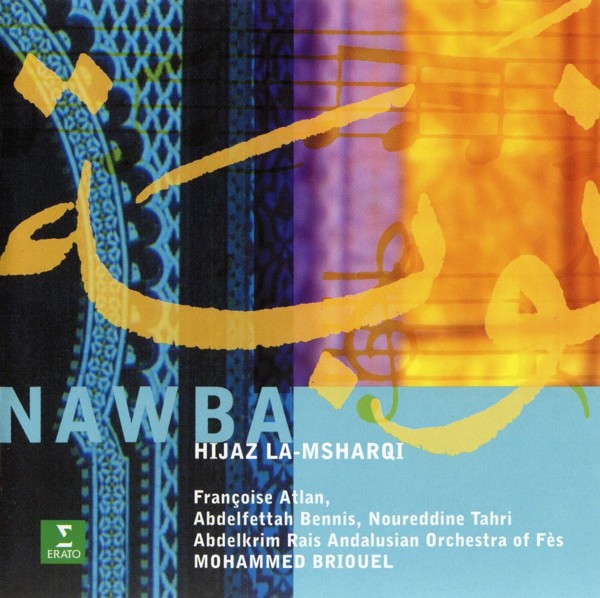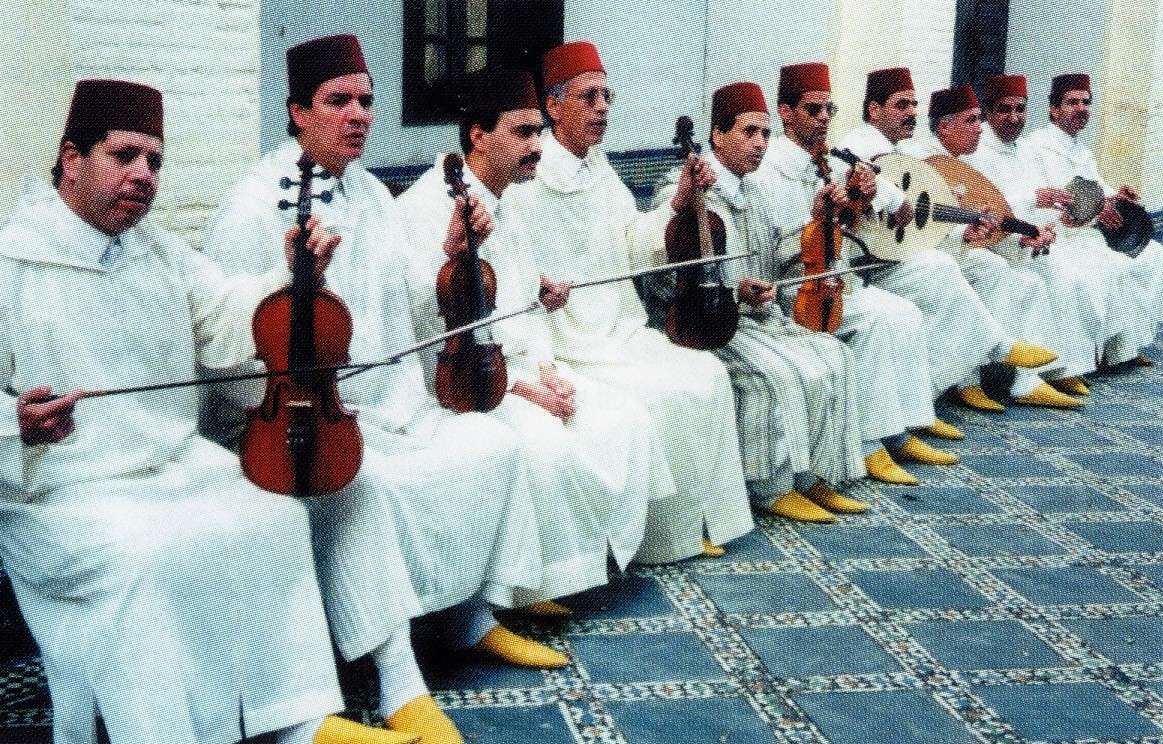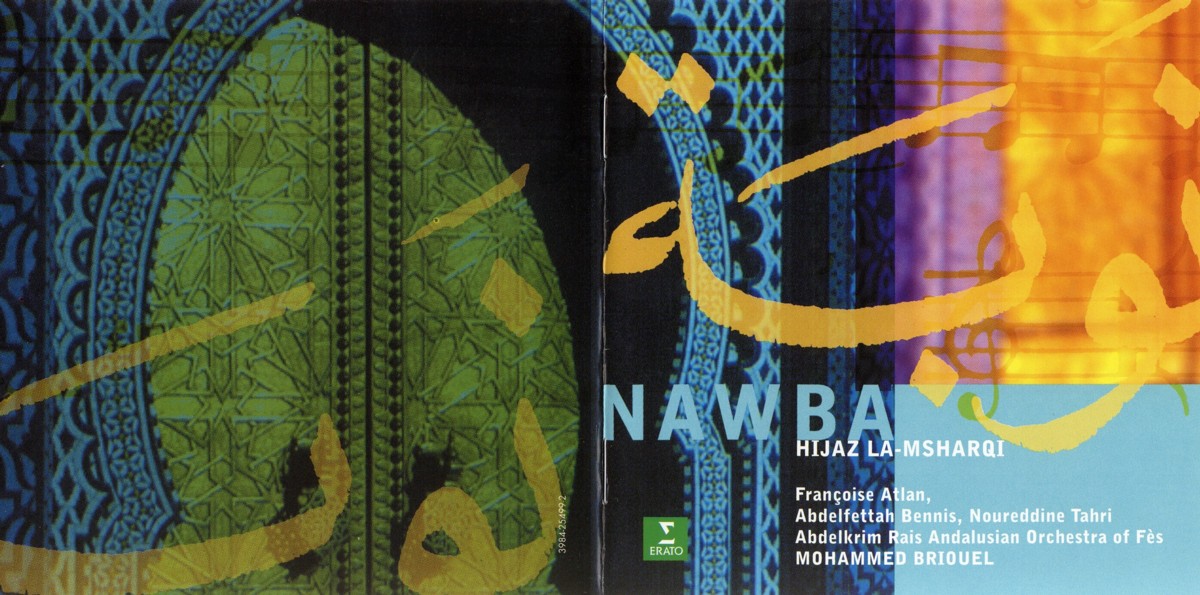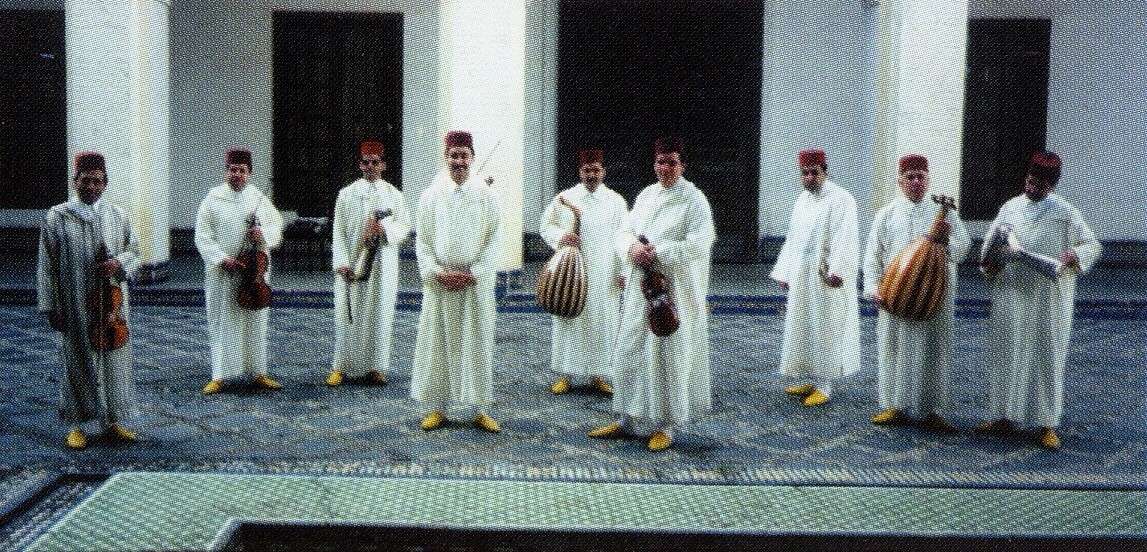
ERATO 3984-25499-2
1999
1. Mizan Bacit [20:14]
2. Mizan Btayhi & Ddarj [32:52]
François Atlan, soprano
Abdelfettah Bennis, tenor
Noureddine Tahri, tenor
Abdelkrim Rais Andalusian Orchestra of Fès
(ORQUESTA ANDALUSÍ DE FEZ)
Mohammed Briouel
Mohammed Arabi, violín
Mohammed Briouel, Dris Bennis, Mustapha Amri, viola
Ahmed Trachene, cello
Abdelhay Bennani, rebab
Abdemahim Otmani, Rachid Lebbar, Ahmed Chiki, ud
Aziz Alami, tar
Abdesslam Amri, darbuka

Recorded in the Mnehbi Palace, in the heart of the Medina at Fès (Morocco)
Producer: Ysabelle Van Wersch-Cot
Sound engineer: Jacques Dolt
Assistant: Didier Jean
Editing: Ysabelle Van Wersch-Cot
Recording: October 18,1998
Recorded using "Audioline Conditionner"
by Hologram', Ch-2400 Le Locle
Cover & Back cover: Royal Palace of Fes (C) HOA.QUI
Design: Erato Disques
Ⓟ & © Erato Disques, S.A, Paris, France 1999
3984-25499-2
Erato web site: www.erato.com

FRANÇOISE ATLAN AND THE ART OF THE MOROCCAN NAWBA
Christian Poché
Here,
we have a most unusual performance: combining the voice of Françoise
Atlan with a vocal art which has been passed down by men's voices is
something as unusual as it is original. The arrival of this new vocal
timbre into the aesthetics of the nawba overturns all the accepted
rules. The performers, led by Mohammed Briouel, conductor of the
Abdelkrim Rais Orchestra (it was Abdelkrim Rais who founded this
orchestra and who was its guide and mentor for over half-a-century;
today, it bears his name and it has become the Fès Orchestra for the
performance of Andalusian-Maghrebian music), had the idea of entrusting
Françoise Atlan with a solo role in order to acknowledge her talent more
suitably. This gives a totally different configuration to the nawba,
one which can be described in the single word, "responsorial". The
chorus of instrumentalists constantly replies to the female voice, for
in the Arab-Andalusian art as it has survived in Morocco, the
instrumentalists double up as singers. Nevertheless, this manner of
singing in reply is not the usual custom in the Moroccan tradition and
even less so in Fès. It is true that in the rare written authorities
that have come down to us on this sophisticated art which is essentially
an oral tradition, there is no mention at all of the distribution of
the vocal parts. Everything here is a matter of conjecture. Moroccan
ensembles as a general rule sing in unison, or at the octave or even in
antiphony. A responsorial system is one unknown to them. It applies more
to the performance of the Algerian nawba, particularly in the closing
section. But responsorial and antiphonal interpretations, and their
variants, are universal forms and they do not conflict in any way with
the original aspects of the art.
But what is it all about? It is
an art born in the country of al-Andalus and handed down from master to
pupil. It took refuge in a few towns in North Africa where it was
constantly developed and enriched in a profusion of sung poems. The
pieces are extraordinarily long, so much so that Moroccan nawbas are no
longer performed in their entirety - performers limit themselves to
choosing a few extracts.
"Nawba" is a term which throughout its
history has been endowed with various meanings. It appears in the
Baghdad of the Abbasid Caliphate, but at that epoch towards the end of
the ninth century, it had quite another meaning: it applied to what was
performed while waiting one's turn in order to go to the palace to play
and sing music before the Caliph. There was a nawba for Thursday,
another for Friday and so on. Once it had travelled towards the west of
al-Andalus, where the frontiers were always subject to change, it took
on an entirely different style: it was a question of performing a
succession of pieces which became ever faster. In essence, these pieces
made up a sung musical suite sustained by instruments amongst which the
lute (ud), the boat-shaped bowed vielle (rebab) and of course a
membranophonic percussion instrument were the principle support and
without which the art could not have been expressed. By announcing the
rhythm, the percussion instrument guaranteed that the message of the
sung text would be properly transmitted. The instrumentation took on
particular importance, and this is reflected in the fact that the word
"ala", by which the art is traditionally known in Morocco, means quite
simply "instrumental".
Thanks to the genius of a compiler named
al-Hâ'ik, who hailed from Tétouan and is thought to have lived in the
eighteenth century, Moroccans now have access to the texts of the poems
of the nawba. al-Hâ'ik assembled them in a manuscript which was included
in an ensemble bearing the title of Kunnâsh, which means a collection
of poems. al-Hâ'ik did not know them all. However, twentieth-century
musicologists have traced other compilers, including al-Bucsami who had
hitherto been neglected. al-Bucsami lived towards the end of the
sixteenth and the beginning of the seventeenth centuries and he, too,
played a leading role in securing knowledge of this heritage.
Nevertheless,
the Moroccans, who are the heirs of the nawba, recognize al-Hâ'ik as
their father and master. It was he who unearthed the existence of eleven
nawbas and codified them. It was he who determined the speeds by
discovering the corresponding musical modes. Arab-Andalusian music as it
is practised in Morocco today does not make use of micro-intervals. As a
general rule, performers from elsewhere do not take easily to it. This
is not the case, however, of Françoise Atlan, who was also trained in
Judeo-Spanish music, and she had no difficulty in adapting to the music,
to her great delight. She also leads the movement (mizân) called basit
(simple) of the nawba Hijâz al-mashriqî with great success, albeit with a
shift in meaning. There is intimate and spontaneous joy in this music
and the listener is also absorbed by the atmosphere of piety which it
distils. This is the usual feeling aroused by the nawba as it is played
today in Tlemcen (Algeria), although not in the sister land of Morocco.
The
nawba Hijâz al-mashriqî, pronounced in dialect lmsharqi, is the ninth
in the order attributed by al-Hâ'ik. The musical scale is based on the
mode of D with the F being raised to F sharp. Although it is a case here
of the heptatonic scale, the nawba traditionally develops around a
narrow range. For the purposes of the present recording, three of the
five opening movements have been selected. There are two nawbas in Hijâz
in the Moroccan tradition: the one known as al-kabîr (the great Hedjaz)
and other called al-mashriqî (Hedjaz from the East). These two modes
have the same scale but they differ in the size of the pivotal steps:
tonic, fifth and octave in the case of the Hijâz al-mashriqi, and tonic,
fourth and fifth in that of the Hijâz al-kabîr.
Noubas are
traditionally performed with a constant increase of tempo. The poems are
for the main part in dialect and develop the three main themes of the
genre: love personified by absence, and waiting which generates passion.
As for nature, it procures an almost drunken state and is often a call
to the divine.
Translation: John Sigdwick

These
poems "HIJAZ LA-MSHARQI" feature in the 9th Nawba; they were produced in
Andalusia in Spain and they continue to be called La-Msharqi on account
of their oriental origin.
The poems sing of the beauty and splendour
of the beloved, going so far as to describe all the various parts of
her body, including every one of them, even those that are the most
intimate and concealed.
They begin with the face, one that is endowed
with features of unheard-of beauty whose charm and brilliance propagate
all sorts of bewitchment and enchantment which never cease to seduce
and fascinate the heart of the poet.
The poet also sings of the
blackness of the beloved's eyes; he sings, too, of her eyelashes and her
eyebrows, comparing them with a host of heavenly delights.
In its
turn, it is the mouth which dazzles, both by its shape and by the smile
which it portrays; in addition, there are the beautiful words which flow
through it, intoned by a most beautiful voice.
The emotion is such that the eternal gaze that is cast upon it could never suffice to quench the thirst to admire it.
The
poet has the impression that sparks fly out from the cheeks of the
beloved. But what exactly are these sparks? They are ones which drive
you to believe that you are in the presence of fairies or of angels
which stretch out their hands to bear you far off, very far off to a
distant and wonderful world where everything is fine and perfect.
There
is a mole on the beloved's cheek, and this in turn helps to bring out
the whiteness of her skin. This mole attracts your attention, whatever
the state of lethargy you might happen to be in. You have the impression
that through this tiny dark dot you can see a host of things that you
endeavour to recognize and identify, but which fly away, leaving room
for others in an infinite cycle.
In this semaâ (group of lines), the
poet moves from a description of the beauty of his beloved's features to
the expression of his feelings for her, saying that everything in this
world will come to an end, everything, that is, save his love for her.
The
poet even goes so far as to swear by all that is most dear to him and
begins by quoting one after the other the forehead, the eyes, the mole
etc. in a manner whereby the words themselves take on a musical
atmosphere.
Mohammed Briouel - Translation: John Sigdwick
